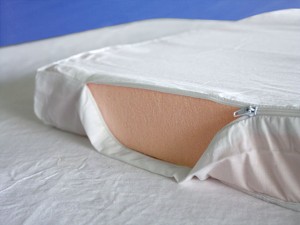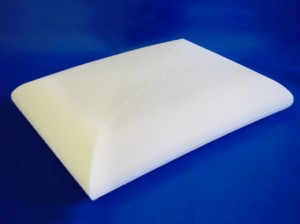Memory foam’s most unique characteristic is its temperature-sensitivity, which is what allows it to offer the custom-contouring the material is so famous for. Engineered with visco-elastic polymers that react to body heat by yielding and softening, memory foam is able to create a surface unique to the user every time they use it, no matter what position. This is true of memory foam mattresses, memory foam toppers, pillows, bolsters, or any other product.

While the material’s temperature sensitivity certainly creates a valuable, one-of-a-kind product, that unique performance characteristic also means people may not be used to how it will behave compared to more traditional materials. It is often inaccurately confused with latex foam as well. While it looks like regular foam, and texture-wise, it feels like any other foam, visco-elastic memory products do not behave in the way you can expect from traditional couch cushions or seat padding. And with its temperature-sensitivity being such a differentiating trait, it only makes sense that knowing how it can affect performance will give you a better understanding of the material. Here are a couple things you can expect out of your memory foam product’s performance in relation to temperature.
Firstly, ambient room temperature does have an impact on memory foam products. A product that will perform differently when subjected to body heat will also be affected by the temperature of the room where it is used. When memory foam beds or pillows are kept in a room with higher temperatures, the material’s physical structure will exhibit reduced viscosity. Viscosity refers to the degree of fluidity in a material; for example, water has lower viscosity than honey. Lower viscosity materials behave more fluidly. Certainly, memory foam will remain a solid regardless of the temperature, but its flexibility is increased with temperature.
Conversely, at cooler temperatures, memory foam exhibits more rigidity and inflexibility. At very cool temperatures, memory foam can actually feel hard initially, until the material is able to warm. The reason this is important to understand is that as seasons or environments change, the performance of the material may as well. As such, understanding that the material is performing in a way that is consistent with its environment, rather than exhibiting signs of failure or manufacturing flaws, is vital to enjoying a memory foam product – especially for first-time users of this material.
In some areas, where the changing of the seasons is barely noticeable, changes in performance will also be miniscule. But in climates where seasons are pronounced – such as Foam Factory’s home state of Michigan – performance and feel in February can certainly be different than during the dog days of summer. Much of this is impacted by the temperature a home is kept at, but generally speaking, homes tend to be warmer in the summer and cooler in the winter. It should be expected that upon getting into a memory foam bed in the winter, it will initially feel firmer, and take longer for contours to form, as the material warms up. Reciprocally, a memory foam topper or mattress in the summer will soften more quickly, and take less time to form to your body. Either way, you will have a pressure-free, cloud-like surface that will help you get fantastic sleep!

There is another temperature factor to consider when dealing with memory foam as well. As the material softens with your body heat, it only makes sense that it would retain some of this warmth, and insulate as well. Due to this, memory foam does tend to sleep more warmly than other materials.
This is something that comes down to personal preference and sensitivity more than anything, and covering fabrics will also have an impact on how much warmth is conducted back to the sleeper. And though it’s not going to be like sleeping on a heating pad, memory foam will also be objectively warmer than something like an air mattress too.
There is a benefit to this, however, particularly in cooler months. As previously mentioned, it may take longer for the material to initially soften in cooler spaces, but when it does, few bedding materials can create a cozier space. As you sink into the softness of memory foam bedding, more of your body is in contact with the material as well, increasing the warmth it will help retain on the coldest nights.
Obviously, memory foam isn’t the right material for everyone. But for the millions of people who have found better sleep and comfort though this material, as well as the millions more considering it as a solution to their problems, having a clear basis for performance expectations is the best way to ensure you get the most from your purchase!


Can hot water bottles be used with memory foam for fomentation of back of persons with disc prolapse.
Yes you may use hot water bottles with our memory foam. Make sure the water does not leak into the foam, otherwise the cover will need to be removed and the foam will need to be air dried.
Will a memory foam mattress tolerate being in a cabin that has no heat all winter long in Michigan?
will freezing affect the mattress quality
Manufacturer states the foam will be OK for temperatures as low as -40 degrees F.
Will the memory foam be okay stored in an area that reaches high temperatures (like 120 deg F)?
Yes, the foam can handle temperatures that high with no negative impacts.
Hi, i ironed a shirt over a memory Foam mattress and now i feel that área softer. Did i ruin It? Thx
You should be OK. Memory foam gets softer with heat normally. Foam in general can handle temperatures under 200F and short bursts under 400F.
I bought a plush memory foam mattress from a dealer in Virginia. It feels firm and nothing like the showroom model which was plush and soft. I suspect a cold delivery truck for this problem. Anyhow, it’s not comfortable fir me to sleep on. What’s the best way to quickly soften the mattress? Should I heat it with an electric blanket? Thank you.
Most memory foam toppers are heat sensitive. After about 1 day the softness should return to normal. Also, with continuous use you should be able to ‘break in’ the memory foam topper as well. Hope this helps.
Is memory foam an option to insulate pipes against freezing? How might it’s properties function in this role?
Typically you would want to use a closed cell foam like polyethylene foam or neoprene foam for insulation.
There is no damage to the quality of the foam with low temperature.
Is there big difference how the foam fells in terms of firmness and comfort in a 22-24°room v.s a 15-20°C room?
What’s the highest temperatures a Memory Foam mattress can sustain & not get ruined, I stay where it gets very hot to 35 degrees Celsius _.
It most cases memory foam in a colder room will feel much firmer at first. Then as the temperature rises with the user, the foam will get softer.
Anything under 140F / 60C will be OK.
I was thinking of using a 3″ Dunlop perforated latex topper as a mattress in a vehicle mounted roof top tent. I live in Phoenix. Is this a suitable application for a latex mattress, or will the heat destroy it? What’s the max temp latex foam can handle?
The latex foam we carry is a very heavy foam. Furthermore, I do not think the latex foam will not be able to handle the heat.
Is it safe to use an electrically heated mattress pad over memory foam or latex foam mattress toppers? Also, could that shorten the life of the topper?
Yes, it should be ok. Make sure there is no exposed wiring and that the heated mattresses pad is in good condition – not worn or damaged. Using the heat pad should not impact the life span of the foam.
I want to move my Tempurpedic mattress across the country. Temperatures are sometimes running 115 degrees outside so a moving van will be hotter. What happens if the mattress is exposed to temperatures well above 150 degrees for up to 4 days?
The foam should be OK. Once the foam is exposed to temperatures above 180F for extended periods of time, the foam starts to degrade more quickly, leading to shorter lifespan for the foam.
My memory form bed has been exposed to 120+ degrees for 30 days. How does this affect the mattress? Will it still be ok or should it be replaced?
The foam should still be OK.
The memory foam bed is for a camper for a tight spot. The camper will not have air conditioning while expansion is that okay.
Yes, this should be OK.
Can a memory foam mattress be left in a camper during temperatures during winter storage without damage?
Yes, this should be OK.
Can I leave a foam mattress (unopened in the original box) in a car overnight with temps above 100?
Yes, that should be OK.
Will the latex mattress feel soFt when I sleep on it in a room with temperatures in the 50 degree range
Our Latex is a foam with a medium feel. The temperature should not effect how this foam will feel.
I find that when I first lie down for the evening, my mattress has good lower back support. However, through the night it heats up, and softens to a point where it no longer supports my lower back. I wake up with back pain every day. It’s been too long for me to return it. Any suggestions for ways to reduce it’s tendency to lose support?
Please Contact Us for further assistance.
Can it be stored unopened in box for 2 or3 months ? And at what temp.? I live in central Alberta, Canada.
We do not recommend keeping any foam product unopened at initial delivery for longer than 2 weeks. Any longer than that can cause the foam to deform permanently. For temperature, the manufacturer states that the foam should be okay in temperatures as low -40 degrees Fahrenheit.
Can you use a heated mattress pad with a memory foam mattress?
Yes, this is possible. Please make sure the heated pad does not have any frayed or damaged wiring before use.
We’re considering using Polyethylene foam for insulation to a building. Would this be a good choice, or what would you recommend?
Typically what is used for building insulation is polystyrene foam.
Can memory foam be compression molded as part of a fabric/foam composite? Curious if preheating of the materials as part of that process causes material breakdown. Or if heat resistance prevents the foam from holding the mold shape once it’s been released from the mold.
We do not recommend heating, cooling, or molding memory foam. Since it is memory foam, it will likely try to come back to the original size.
I live in phoenix. Will memory foam be ok in our travel trailer when not in use during the summer with temps well over 100 outside?
Our Memory Foamis not specifically tested for these circumstances. Heat will soften the foam when in use. If constantly in the heat, it may shorten the lifespan of the foam, but not significantly. Contact Usfor more information.
I keep my bedroom cold in wintertime..50 degrees and I like a heating blanket to heat my bed,so it’s warm when I get in,then I shut it off..I just bought a tempur foam topper for my bed.can I still use my heating blanket to get my bed warm?
This can vary depending on the brand of memory foam that you have. Our Memory Foamwould be okay to use a heated blanket on, however, you would not want to leave it on constantly. What will happen is that the heat will cause the memory foam to soften and become more easily contoured.